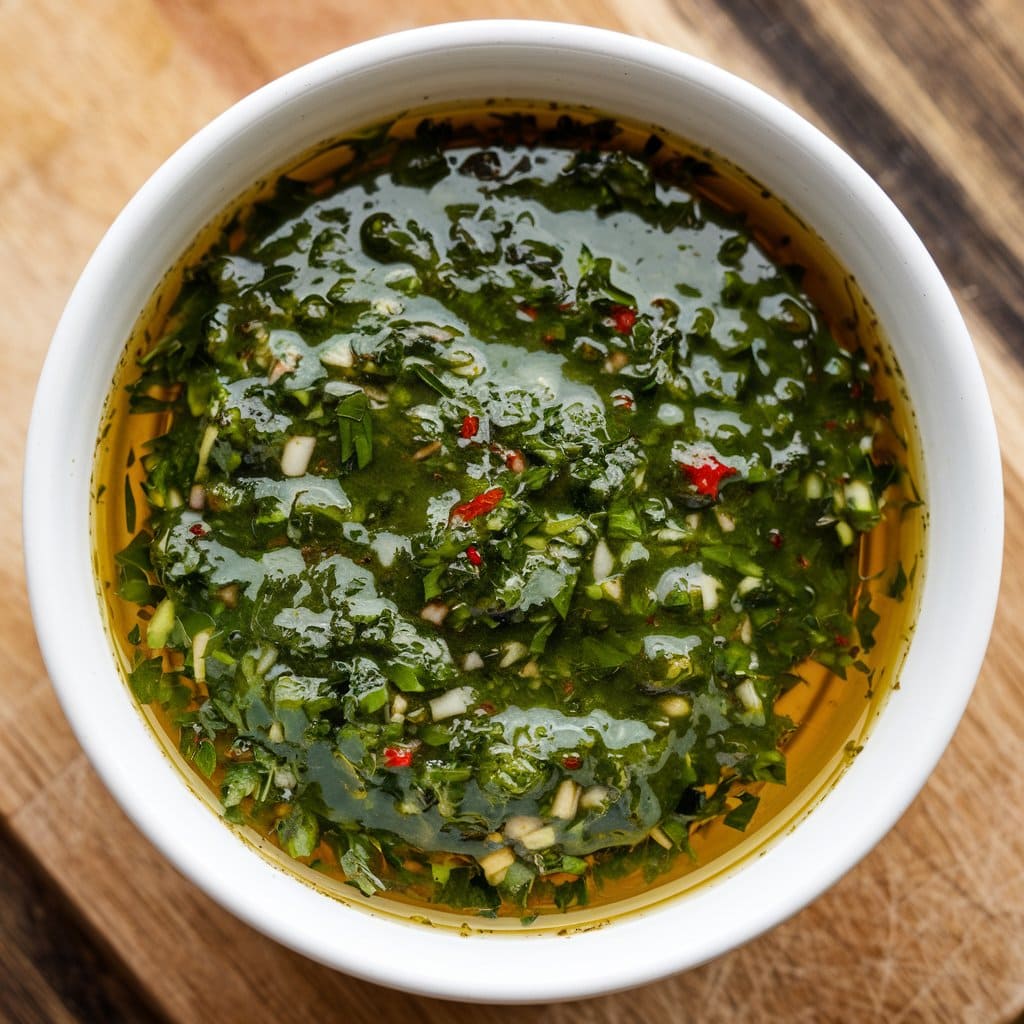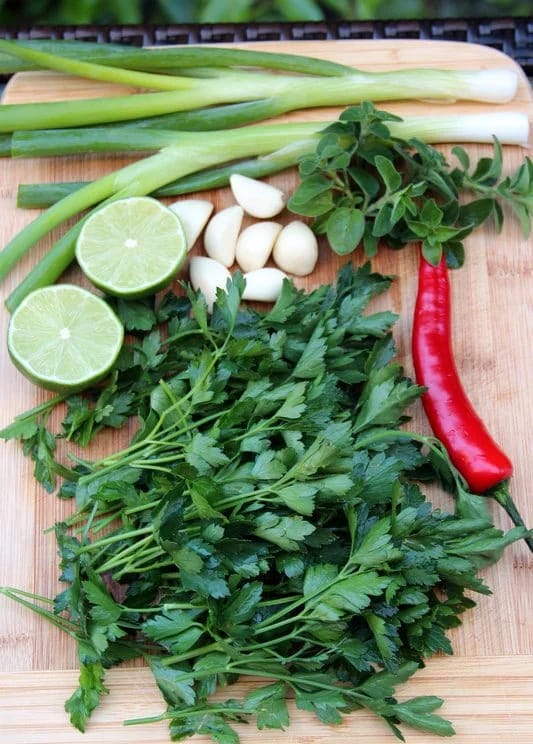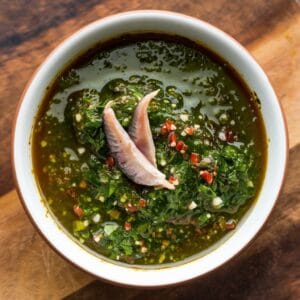When it comes to vibrant, zesty condiments that can elevate any meal, few can rival Sauce Chimichurri. Prized in Argentine cuisine, chimichurri sauce is a bright blend of fresh herbs, tangy vinegar, piquant garlic, and rich olive oil. Whether you’re a home cook searching for an easy chimichurri sauce or exploring a new spin on an authentic recipe, this comprehensive guide will teach you how to make chimichurri from scratch, using essential ingredients and straightforward steps.
In the following paragraphs, we’ll explore the origins of this beloved sauce, delve into its main components, and provide detailed instructions. We’ll also discuss tips for adapting your Chimichurri sauce to diverse diets and flavor preferences, ensuring you can achieve perfect results at home. By the end, you’ll walk away fully equipped to incorporate this tangy, herbaceous sauce into countless dishes—unlocking new dimensions of flavor in everything from grilled meats to roasted vegetables.

Table of Contents
Why You’ll Love Sauce Chimichurri
Chimichurri sauce is known for bringing a bright, bracing element to everyday meals. While it’s most strongly associated with Argentina, its appeal is global. Consider these compelling reasons if you’re on the fence about trying to make it at home.
Perfect for Families, Quick, and Delicious
Sauce Chimichurri comes together in mere minutes—especially when you have a reliable blender or food processor at your disposal. It’s an easy sauce that packs a serious flavor punch without hours of cooking time. This quickness makes it ideal for busy families who still want to serve something homemade and unique. If your weekday schedule is packed but you crave fresh accompaniment, chimichurri has you covered. Even on a lazy weekend, making a small jar of sauce is an effortless and rewarding project.
Nutritional Benefits and Simple Ingredients
One reason why many people appreciate a good chimichurri recipe is that it combines naturally wholesome ingredients. Fresh herbs, garlic, and olive oil are cornerstones of a healthy diet, each boasting a range of vitamins, antioxidants, and beneficial fats. Herbs like parsley, cilantro, and oregano are known for their micronutrients and anti-inflammatory properties. Garlic supports heart health and adds complexity. Olive oil, particularly extra-virgin, provides monounsaturated fats that may benefit cholesterol levels. Collectively, these simple, natural components yield a sauce that’s not just delicious but also nutritionally rewarding.
Adaptability and Budget-Friendly Options
Chimichurri sauce can be made exactly how you like it—mild or spicy, thick or light, with or without extra herbs. If you’re on a budget, you can also source the primary ingredients for minimal cost. Parsley and garlic are widely available and typically inexpensive. A single batch of chimichurri can last for days in the fridge, meaning you’ll have a ready-made flavor enhancer that saves time and money. Its versatility extends further when considering that a small spoonful can transform basics like grilled chicken, eggs, or roasted veggies into a more intriguing, flavor-packed dish.
Essential Ingredients for the Recipe
While different cooks have their signature twists on Sauce Chimichurri, there’s a generally agreed-upon foundation for this iconic condiment. Let’s break down what you’ll need and explore how to adapt each element based on taste or availability.
Fresh Herbs (Parsley, Cilantro, or Oregano)
Role: The key to a fantastic chimichurri sauce is a robust blend of fresh green herbs, primarily parsley. This creates the sauce’s distinctive, vibrant color and bracing flavor. Cilantro is also sometimes added, especially if you prefer a slightly brighter, citrusy note in your sauce.
Alternatives: If you dislike parsley or can’t source fresh leaves, you might experiment with basil or mint for unique spins on the classic. Dried herbs can be used in a pinch, though the flavor will be more subdued.
Garlic
Role: You can’t discuss a proper chimichurri recipe without highlighting garlic. Its pungent, spicy undertones underscore the tangy and herby notes, making each bite more dynamic.
Suggestions for Variations: For a milder flavor, roast the garlic beforehand. This approach tames the heat and imparts a mellow sweetness. Alternatively, if you adore garlic, don’t hesitate to include an extra clove or two—beware that raw garlic can become overpowering if you’re not accustomed to its intensity.
Olive Oil, Vinegar, and Seasonings
Role: A hallmark of how to make chimichurri is balancing tangy vinegar with fruity olive oil. These two liquids fuse to form a bright, flavor-carrying base that envelops the herbs.
Practical Tips:
- Olive Oil: Extra-virgin olive oil is ideal for a richer taste. However, you can opt for a lighter oil if you want the herbs to dominate.
- Vinegar: Red wine vinegar is standard, though white or apple cider vinegar can also work. Balsamic vinegar is less common due to its sweetness, but it can produce a unique flavor profile if used sparingly.
- Salt, Pepper, and Optional Chili Flakes: Seasoning is crucial to highlight each ingredient’s natural flavors. Chili flakes or fresh chili peppers are optional but recommended for those who appreciate some heat.
Ingredient Preparation
Some prep goes a long way before you start whipping up your easy chimichurri sauce. Even if you’re short on time, following these steps sets you up for a bold, fresh outcome.
Washing and Drying Herbs
Instructions: Rinse your fresh parsley (and cilantro, if using) under cool running water to remove any debris. Shake off as much water as possible, then pat the leaves dry with a clean kitchen towel. Eliminating excess moisture helps the oil blend smoothly, preventing a watery consistency.
Time-Saving Tip: If you plan ahead, you can wash and dry the herbs in advance. Store them in the fridge, wrapped in a paper towel, to keep them crisp until you’re ready to chop.
Chopping or Mincing
Following Action: Depending on personal preference and the tools at your disposal, you can finely chop the herbs by hand or use a food processor. For the garlic, peel the cloves and remove any green shoots inside if you want a milder, less bitter taste. If you like a chunkier sauce, hand-chopping everything can yield a satisfying, rustic texture. For a smoother sauce, pulse the ingredients briefly in a blender or processor.
Time-Saving Tip: Pre-peel garlic cloves and store them in an airtight container in your fridge. You can also buy them pre-peeled but note that their flavor can degrade faster.
Setting Out Oils, Vinegars, and Seasonings
Final Description: Have your olive oil, vinegar, salt, pepper, and optional chili or paprika close by. This step ensures you won’t scramble mid-process to find the right ingredient, preventing over-chopping or letting the herbs sit too long once minced.
Step-by-Step Cooking Instructions
While “cooking” might be misleading for an essentially raw sauce, a method exists to assemble and balance the flavors in a chimichurri sauce. Below, we’ll walk through the process in detail.
Ingredients
- 1 cup fresh parsley, finely chopped
- ½ cup fresh cilantro, finely chopped (optional for a more vibrant flavor)
- 4 garlic cloves, minced
- 2 tablespoons red wine vinegar
- ½ cup olive oil
- 1 teaspoon dried oregano
- ½ teaspoon red pepper flakes
- Salt and black pepper, to taste
- Juice of ½ lemon (optional, for added freshness)

Step 1 – Initial Preparation
- Gather Equipment: Prepare a medium-sized mixing bowl (or the bowl of your food processor).
- Check for Freshness: Ensure that your herbs haven’t started to wilt. If they have, trim off browned or slimy leaves.
- Optional: Mild Heat: To soften the garlic’s edge, briefly sauté minced garlic in olive oil over low heat, but avoid browning it. This is not traditional but beneficial if raw garlic overpowers your palate.
Step 2 – Ingredient Assembly
- Combine Herbs and Garlic: Place chopped parsley (and cilantro, if using it) in a bowl. Add finely minced or crushed garlic.
- Drizzle in Oils and Vinegar: The ratio of oil to vinegar varies by preference, but a standard guideline is about two parts oil to one part vinegar. If unsure, start with a smaller amount of vinegar; you can always add more for extra tang.
- Season Generously: Sprinkle in salt, freshly ground black pepper, and, if desired, chili flakes or chopped fresh chili peppers. The key is to gradually taste and adjust rather than dumping everything in.
Step 3 – Finishing Touches
- Combine Thoroughly: Stir the mixture slowly, observing how the oil and vinegar distribute throughout the herbs. If the mixture seems too dry, add a dash of more oil. If it lacks brightness, incorporate a spoonful of vinegar.
- Taste and Refine: Sample a small spoonful. Is it too garlicky, or do you crave more salt? Adjust accordingly. Remember, flavors meld over time, so minor bitterness or tang might mellow out.
- Let the Sauce Rest: While you can serve chimichurri immediately, many cooks prefer to let it sit for at least 15–30 minutes to allow the flavors to develop.
Tips for an Even Tastier Version
Once you’ve nailed the standard technique, consider experimenting. A well-crafted chimichurri can be a springboard for numerous variations.
Adding Extra Ingredients
- Roasted Red Peppers: Blend some roasted pepper into the sauce for sweetness and color contrast.
- Citrus Zest: Lemon or lime zest can enhance the zing and marry well with cilantro if you’ve included it.
- Onions or Shallots: Some cooks like chopped onions or shallots for an extra bite. Just be mindful that these ingredients can intensify over time.
Techniques to Enhance Flavor
- Marinating Proteins: Before grilling steak, chicken, or fish, try using your Sauce Chimichurri as a marinade. The acid from the vinegar helps tenderize the meat, infusing it with vibrant herb notes.
- Pan Drizzle: You can swirl a spoonful of chimichurri into pan sauces for a punch of freshness, especially after sautéing veggies or shrimp.
- Overnight Fusion: If you can plan, let your chimichurri rest in the fridge overnight. The flavors often intensify, giving you an even more robust sauce the following day.
Adjustments for Preferences
- Low Oil Version: If you’re watching fat intake, reduce the amount of oil and supplement with a tablespoon or two of water or stock. Though you’ll alter the texture, the overall taste can remain bright.
- Lower Acid: Some individuals prefer a milder tang. If that’s you, reduce the vinegar or swap half with a splash of lemon juice for subtlety.
- Spice Level: Skip chili flakes if you don’t enjoy the heat. Conversely, spice enthusiasts can incorporate fresh jalapeños or a pinch of cayenne.
Recipe Variations and Adaptations
A classic chimichurri sauce is built around parsley, vinegar, garlic, and oil, but part of its charm is how well it accommodates creativity. Below are a few adaptation ideas for different dietary choices and flavor aspirations.
Vegetarian Option
Replace Meat With Plant Proteins: Chimichurri is often paired with steak, but for vegetarians, it works brilliantly on grilled tofu or roasted chickpeas. You can also drizzle it over hearty vegetables like eggplant, zucchini, or cauliflower steaks, instantly dressing them up with Argentinian flair.
Gluten-Free or Low-Carb Option
Focus on Naturally GF & LC Ingredients: This sauce is typically gluten-free, provided your vinegar contains no malt-based additions. Choose cauliflower rice or a leafy greens salad instead of bread if you’re serving it with a side. The sauce’s brightness complements the mild flavors of non-starchy vegetables, making it an easy fit for a low-carb lifestyle.
Other Adaptations
- Seasonal Twists: In the summertime, combine fresh and chopped tomatoes for a chunkier consistency. In winter, experiment with dried oregano to accent the fresh parsley.
- Infused Oils: For a subtle difference, use olive oil infused with garlic, rosemary, or chili. This layering effect can create a more nuanced taste.
Serving Suggestions
Chimichurri sauce is traditionally served as a condiment alongside grilled meats, but its uses are as varied as your culinary imagination. If you’re seeking inspiration for pairing, here are some helpful ideas.
Salad or Soup Ideas
- Green Salad Starter: Toss fresh greens—arugula, spinach, or romaine—with a splash of chimichurri for a tangy dressing. Consider adding feta or goat cheese for a creamy counterpoint.
- Soup Garnish: Drizzle a spoonful of chimichurri into a hearty soup, such as lentil or roasted tomato soup, just before serving. The bright color and flavor pop can transform a simple bowl into an elevated dish.
Hearty Sides
- Homemade Bread: A rustic loaf of crusty bread can be perfect for soaking up leftover chimichurri from your plate. Alternatively, you can use it to create a dipping station with olive oil and your fresh sauce.
- Roasted Vegetables: Carrots, potatoes, and peppers assume a bolder character once you’ve tossed them in or served them with a side of chimichurri. This bright green sauce contrasts nicely with the sweet earthiness of roasted roots.
Drink Recommendations
- Tea: A simple green tea or herbal infusion can cleanse your palate, balancing the sauce’s boldness.
- For a robust pairing, consider an Argentine Malbec, which complements the sauce’s acidity and is a natural match for grilled steak. White wine lovers might enjoy a crisp Sauvignon Blanc that echoes the sauce’s herbaceous notes.
- Mocktails: If you prefer non-alcoholic beverages, a citrusy mocktail with lime, mint, and sparkling water beautifully complement the tangy chimichurri.
Storage and Reheating Tips
Because chimichurri is largely uncooked, proper storage can help you prolong its freshness and flavor. Below, we’ll walk through how best to store your sauce and reintroduce it into your meals throughout the week.
How to Store Leftovers
- Refrigeration: Transfer the sauce to a glass jar or airtight container. Chimichurri should remain fresh in the fridge for up to one week, though the herbs may darken slightly.
- Cover with Oil: If you plan to store it longer, add a thin layer of olive oil. This barrier can help prevent oxidation and keep the flavors vibrant.
Reheating Techniques
Chimichurri is typically served at room temperature or chilled. However, if you’d like to incorporate it into warm dishes:
- Oven or Stovetop: Gently warm a small portion in a saucepan over low heat. Prolonged heating can mute the fresh herbal notes, so a quick pass through the pan is usually enough.
- Microwave: While you can microwave a spoonful to take the chill off, do so in short intervals to avoid cooking the sauce. Overheating or boiling your chimichurri might cause the herbs to brown and become bitter.
Portioning Tips
If you’re into meal prep or plan to enjoy chimichurri throughout the week, dividing it into smaller containers or freezer-friendly portions can be beneficial. That way, you only handle what you need and preserve the rest in its freshest state.
Nutritional Information and Benefits
A good chimichurri sauce proves that healthy eating doesn’t need to be dull. Each element, from fresh parsley to high-quality olive oil, brings flavor and notable nutritional value.
Nutritional Values per Serving
Exact values will differ based on ingredient ratios, but a standard two-tablespoon serving of chimichurri may contain approximately:
Nutrition Information (Per Serving)
- Serving Size: About 2 tablespoons
- Calories: 80
- Sugar: 0g
- Sodium: 75mg
- Fat: 9g
- Saturated Fat: 1.5g
- Unsaturated Fat: 7.5g
- Trans Fat: 0g
- Carbohydrates: 1g
- Fiber: 0.3g
- Protein: 0.3g
- Cholesterol: 0mg
Ingredient Benefits
- Parsley and Cilantro: Source of vitamins A and C, plus various antioxidants.
- Garlic: Contains allicin, which may support heart health and exhibit antimicrobial properties.
- Olive Oil: Rich in monounsaturated fats, beneficial for heart health when consumed in moderation.
- Vinegar may aid digestion and help balance flavors without adding excessive calories.
Recommended Portions
Because chimichurri is so flavorful, a little goes a long way. A tablespoon or two per serving is sufficient. However, if you enjoy stronger flavors or prefer to marinade, you can scale the portion accordingly.
Common Mistakes to Avoid
Minor missteps can affect the final taste and texture, even with an easy chimichurri sauce. Let’s discuss a few typical pitfalls and how to dodge them.
Over-Blending the Herbs
Description: When using a blender or food processor, it’s easy to pulverize the herbs until they become a puree instead of a finely chopped mixture. Over-blending can produce a sauce more like a paste than the bright, loose mixture you expect.
Solution: Pulse the ingredients in short bursts or chop them by hand. Check the consistency, especially if you prefer a chunkier sauce.
Overpowering Raw Garlic
Description: While garlic is integral to the chimichurri recipe, too many raw cloves can overwhelm the other flavors or produce a harsh sauce on the palate.
Tips to Improve: Start conservatively with one or two cloves, taste, and add more if you love garlic. Alternatively, consider roasting or lightly sautéing the garlic to soften its intensity.
Forgetting to Taste and Adjust
Description: The difference between a good and great sauce often lies in fine-tuning salt, vinegar, and heat. Skipping a final taste test can leave your sauce unbalanced.
Expert Advice: Always sample your chimichurri before serving. If it’s missing brightness, add a hint of more vinegar, and if it’s too tangy, mix in a drop of olive oil or a small pinch of sugar. This approach ensures a well-rounded flavor.
Inspiring Conclusion
Sauce Chimichurri is a straightforward and immensely rewarding condiment. It celebrates fresh, wholesome ingredients and invites you to play with flavors, making every dish—steak, veggie, or sandwich—more enticing. By mastering making chimichurri, you unlock the door to countless kitchen experiments, fueling creativity and excitement around mealtime.
Feel free to adapt this sauce to your tastes or collaborate with friends and family to see how their versions compare. Cooking is, after all, a communal endeavor best enjoyed with others. So whip up a bowl of chimichurri sauce, share it at the dinner table, and see how a drizzle of herbaceous, garlicky goodness can transform everyday fare into something special.
FAQ (Frequently Asked Questions)
Below are 10 common questions about making and using chimichurri sauce, each answered to guide you toward perfect results.
- Can I prepare this recipe in advance?
- Absolutely. Chimichurri often tastes better after it has rested for a few hours or even overnight, allowing flavors to meld. Store it in the fridge and stir before serving.
- What are the best substitutes for parsley?
- While parsley is traditional, you can use cilantro, basil, or even mint for different flavor profiles. Basil brings a sweet note, while mint introduces a refreshing twist.
- How can I make the sauce spicier?
- Add fresh chili peppers, such as jalapeños or serranos, or sprinkle in chili flakes or cayenne pepper. Adjust the quantity slowly to avoid overwhelming the other flavors.
- Does the vinegar type matter?
- Red wine vinegar is classic. However, white wine vinegar, apple cider vinegar, or even champagne vinegar can each add distinct tanginess. Avoid overly sweet vinegar like balsamic unless you’re after a sweeter sauce.
- Is chimichurri always green?
- Chimichurri can be red with tomato or red peppers and a heavier spice blend. However, the green version is most common worldwide.
- How long will my chimichurri last in the fridge?
- Typically, it takes up to a week if stored properly in an airtight container. The herbs may darken, but the taste remains unless there’s mold or an off odor, in which case discard it.
- Can I freeze chimichurri?
- Yes, you can. Freezing in ice-cube trays allows you to thaw small portions simultaneously. Just expect a slight change in texture upon thawing.
- What if my sauce is too oily?
- Add more vinegar or a small amount of water to balance the texture. You can also incorporate more chopped herbs to absorb excess oil.
- Can I add citrus juice to my chimichurri?
- Absolutely. A splash of lemon or lime juice can brighten the sauce. Some cooks replace half the vinegar with fresh citrus juice for an even zestier result.
- Does it pair well with seafood?
- Yes. Chimichurri’s tang and herbal quality work beautifully with grilled shrimp, salmon, or white fish. Try marinating fish fillets in a mild portion of chimichurri before cooking, then serving them with an extra sauce drizzle.

Sauce Chimichurri
Ingredients
- 1 cup fresh parsley, finely chopped
- ½ cup fresh cilantro, finely chopped (optional, for a more vibrant flavor)
- 4 garlic cloves, minced
- 2 tbsp red wine vinegar
- ½ cup olive oil
- 1 tsp dried oregano
- ½ tsp red pepper flakes
- Salt and black pepper, to taste
- Juice of ½ lemon (optional, for added freshness)
Instructions
- Step 1: Prep Your IngredientsWash and dry the parsley and cilantro thoroughly. Finely chop the herbs.
- Step 2: Mix the BaseIn a medium bowl, combine the parsley, cilantro, garlic, dried oregano, and red pepper flakes.
- Step 3: Add the LiquidsStir in the red wine vinegar and olive oil until well combined.
- Step 4: Season and AdjustAdd salt and black pepper to taste. If desired, squeeze in the lemon juice for extra brightness.
- Step 5: Let It RestAllow the chimichurri to sit at room temperature for 10-15 minutes to let the flavors meld together. Serve fresh!
Notes
- Chimichurri tastes even better after a few hours as the flavors develop.
- Use immediately or store in an airtight container in the refrigerator for up to a week.

